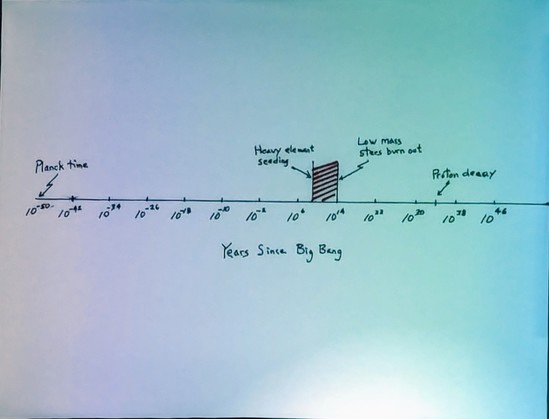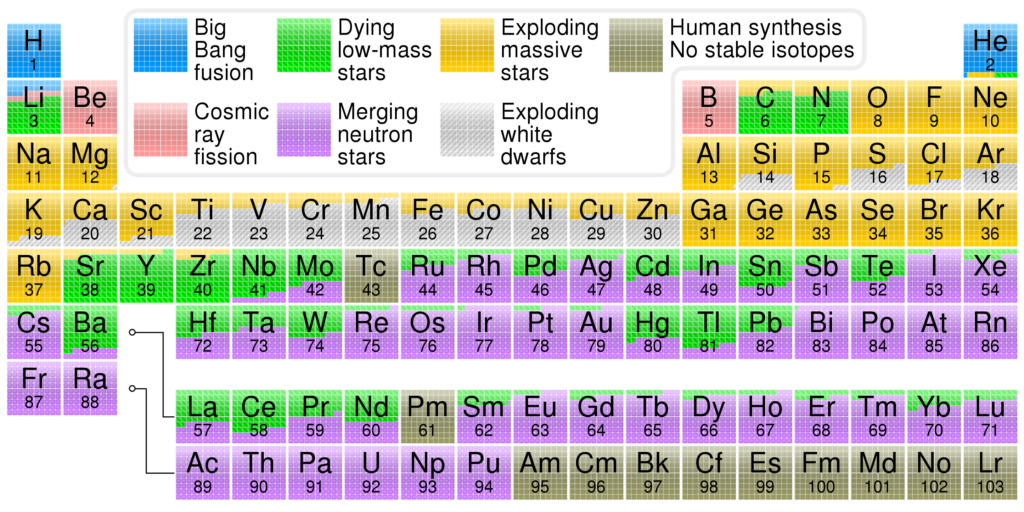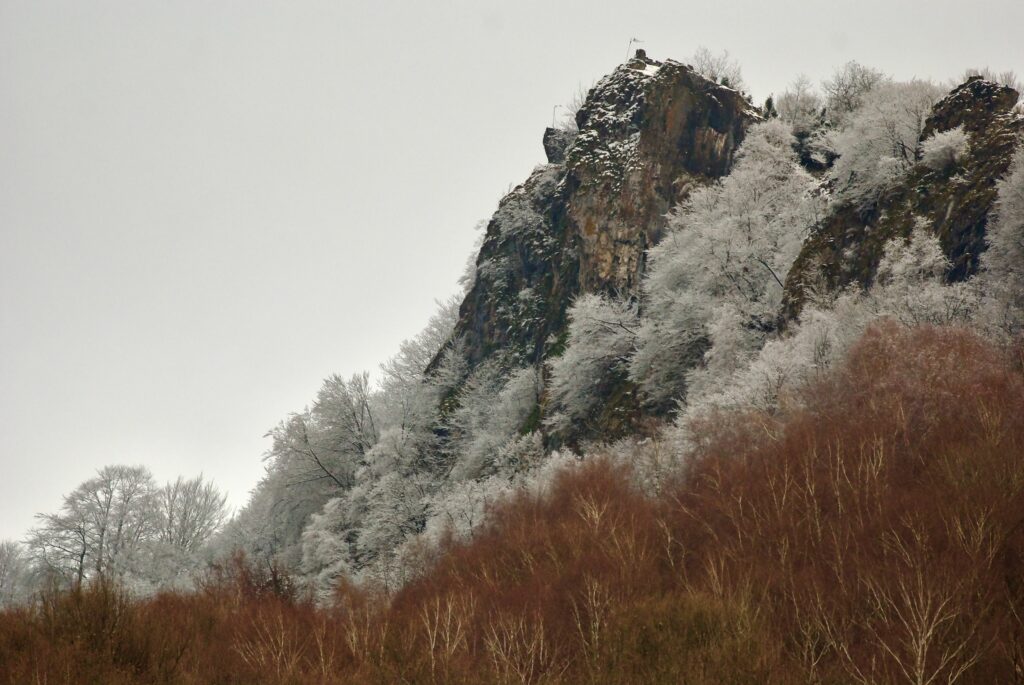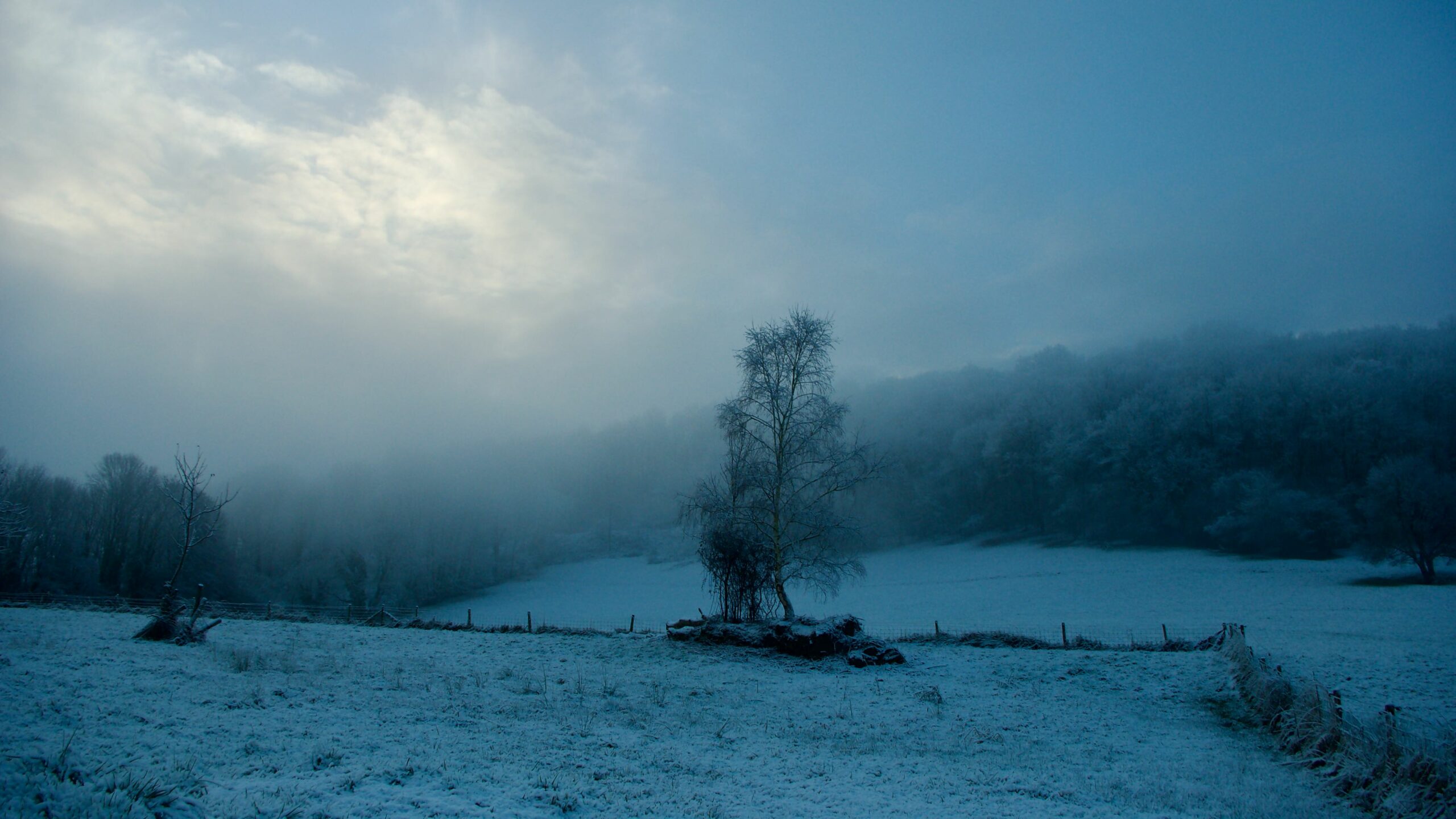Life, and its diversity on Earth, can be envisioned as an integral part of the story told by astrophysics and cosmology. Conversely, we may want to frame the structure and evolution of the Universe, and its various physical bits, with respect to the complexity of life and ecosystems. Let me explain this (very scientific) idea !
This week, I saw an interesting post by Kelly Lepo in my mastodon TL, reporting on a plenary talk by renowned MIT astrophysicist Alan Lightman on “The Rarity of Life in the Universe” at the American Astronomical Society annual conference. Kelly posted a snapshot of one of the slides, a very simplified timeline of cosmic evolution, which I thought could serve as a neat starting basis for this post.

Disclaimer: I haven’t seen the talk, but the story probably went that way: according to what we know about the Universe, the light elements Hyrogen and Helium formed during the first 20 minutes of the Universe, or 0.0001 yr after the Big Bang, a phase we call big bang nucleosynthesis. The position of this time in the plot above corresponds to the letter “a” in the x-label word “Years”. All heavier elements, except for a wee bit of Lithium, only started to form much later, when the first dense matter structures of the Universe formed by gravitational collapse. In fact, elements up to iron in periodic table, including most elements we think are needed for life to develop, e.g. Carbon, Nitrogen, Oxygen, or Phosphorus, only started to be forged in the first stars by nuclear fusion a few hundred million years (108 yrs) after the big bang, and then started spreading through forming galaxies as the first massive stars exploded and corresponding lower mass stars came to the end of their longer lives a bit later, spitting out winds seeding these elements in surrounding pristine molecular clouds in the process, forming the next generation of stars…plus now planets made of such elements. This, in a nutshell, is the well-known “we are all made of stardust” story.

The production of these elements (and heavier ones through more advanced stages of stellar evolution, such as compact objects mergers and explosions) is supposed to continue until there’s no fuel anymore to sustain star formation, something we think will happen somewhere between 1012 (a thousand billion yrs) and 1014 years (hundred thousand billion yrs — reminder that the Universe is currently estimated to be ~13.7 billion years old !). These two important times, the beginning of star formation and the first supernovae explosions at a few 108 yrs, and the end of star formation at 1014 years, are those indicated in the seemingly innocuous Lightman’s plot above (and now you can see that this simple drawing actually encapsulates a lot of advanced astrophysics material !). The hatched zone inbetween corresponds to the time during which heavy elements, and therefore life, can be forged. In fact, we are already past cosmic noon, when star formation, and the formation of elements essential to life, peaked.
From there, we can take a step back and look at this timeline from far away enough, for instance as is done in this plot by using a log scale which indexes times by powers of ten, to realize that the formation of life is in fact only possible during a blink of the eye in the full history of the Universe (fortunately for us, this time is also much shorter than the lifetime of protons, also indicated in the plot, so that atomic nuclei indeed exist). We can consider ourselves somewhat lucky to live in such interesting times, when stars shine and complex things happen, but it could also not be otherwise, because we are simply part of this very transient complexity !
The story told by Alan Lightman’s slide tells us about the rather special position in time of life and nature on Earth in the grand cosmological and astrophysical picture, but we can also consider this question from a finer astrophysics perspective (I don’t know if Lightman also talked about more detailed contingencies for life, although he is more than likely to have done so). For instance, if there were no stars in the first place, not only would there have not been the elements necessary to build planets, there would also have been no protoplanetary accretion disk structures (planetary nurseries) at all. And, if there was no significant starlight, such as was the case before reionization ~150 million yrs after the big bang (1.5 108 yrs, corresponding to the formation of the first stars), it is unclear how much of the complexity of life as we experience it on Earth may be possible on planets orbiting their stars. On Earth at least, photosynthesis appears to be a very ancient thing, which new research suggests currently started at least 1.75 billion years ago. Without starlight, it would also be freaking cold out there for life…but stars are also nuclear furnaces ! For this reason, lots of research on exoplanets focuses on finding planets in the so-called “Goldilocks” zone, namely at an orbiting distance from the star that is just about not too cold, but also not too hot for complex molecules and liquid water to be present. Yes, today you learned that the Earth is a bit like our Mama bear, and we must take great care of our mamas.
More generally, it is possible that there are many, many conditions required for life to be possible that depend on detailed bits of astrophysics, and could make life a relatively rare, or at the very least a remarkable non-trivial outcome of the evolution of the Universe. One of them has to do with the very existence and amplification of electromagnetic fields in the history of the Universe, a subject dear to my astrophysicist heart. But I digress…I promise I’ll talk about this one in the future.

Now that we have learned about ecostrophysics, i.e. how life, nature, and its diversity necessarily contextually derive from what is happening in the grander scheme of physics in the Universe, let us take the problem backwards and ask: how complex and special is the distribution and organization of matter and energy in the Universe, compared to that of life and its diversity on Earth ? Physically, we know for certain that life and complex molecules are just a tiny fraction of the total mass and energy content of the Universe. However, intuitively (from an anthropic perspective), in terms of complexity at least it also seems to be the most feature-packed thing ever made in and by the Universe. Could we then contextualize the complexity of the broader Universe (minus life) with respect to life and ecosystems, and how could we do this in quantitative terms ? I don’t have a detailed answer to this question and suspect nobody does (or, to state it differently, I don’t think there is an established scientific consensus on such questions). I may well be wrong and would be delighted to be enlightened if you have some relevant (not crackpot) references to point to me on this question (and yes, I already know about Gaïa).
Making progress on this kind of problems likely requires quantifying the information content of different types of self-organized complex structures (either individual or collective) and correspondingly fiddling with physics concepts like entropy and kinetics. Accordingly, there’s already a lot of research and literature in ecology (and similarly in other complex science fields) about whether ecosystems tend towards maximum entropy states. This idea stems from equilibrium statistical physics but when we talk about open, out-of-equilibrium systems, everything is awfully complicated and I am not sure for instance that we have the slightest idea how, and the mathematical tools to tackle the kinetics of self-organization properly (because all that stuff keeps evolving), just as we still don’t know very well how to handle gas or plasma kinetics or relaxation of many body systems in galactic dynamics. I actually submitted a proposal last year to setup a collaborative interdisciplinary research program on this kind of questions (unfortunately it was rejected, but I’ll try again !) to compare the complexity and dynamical evolution of ecological systems on Earth to that of the broader Universe, in order to put both in a mutual, hopefully enlightening perspective. With a neurologist friend of his, my astrophysics colleague Franco Vazza already dipped his toes into a similar problem, trying to compare the complexity of the cosmic web of large-scale structures in the Universe to that of the human brain, and found some similarities. Is complex structure formation in some way renormalizable at all scales ?
As you may guess, and as Franco experienced, such questions are to crackpots, intelligent designers and people doing metaphysics and philosophy as a day job what honey is to flies. How to address them properly, in a rigorously way that adheres to the rules of science, is however in itself quite a difficult problem, albeit an exciting one ! I suggest cheekingly calling such a field of research astrocology.


Leave a Reply